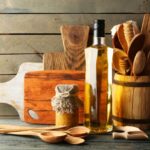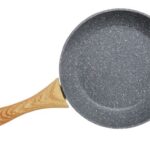The wooden handle allows for a firm grip and stays cool when cooking on the stove. Wooden-handled pans are great for certain types of cooking and are popular with people who prefer to shake and turn food while cooking. The most common types of cookware with wooden handles include skillets, woks, deep fryers, pots, and cast iron skillets.
Why Do Some Cooking Pans Have Wooden Handles?
1. Wood Handles Keep your Fingers Safe
Metal cookware can cause serious burns if you grab the handle while cooking on a hot stove. Although the metal handles are useful for finishing cooking in the oven, they are not practical if you need to hold the pan while cooking. Before touching the hot metal handle, you must use an oven mitt or kitchen gloves to protect your fingers from accidental burns.
The situation is completely different if you use a pot or pan with a wooden handle. Wood is an insulating material and takes a long time to warm up. The wooden handle stays cool throughout the cooking process. You can easily hold the handle with one hand and mix the food with the other hand.
Woks with wooden handles are particularly popular because the contents they contain require intensive frying and stirring as well as the frequent movement of the pan.
2. Firm and Comfortable Grip
Wooden handles fit securely and comfortably in the hand. This is an advantage when preparing dishes that need to be tossed, fried, or turned. Wood is lighter than metal, so a pan with a wooden handle is lighter than a pan with a metal handle and is easier to hold and move when cooking and serving food.
If you enjoy cooking Asian dishes, a wooden handle provides a firm grip while you toss and stir ingredients in a wok.
Some leading brands such as Le Creuset produce frying pans with wooden handles that focus on ergonomics.
What are the Disadvantages of Pots and Pans with Wooden Handles?
1. Can’t Go in the Dishwasher
Unfortunately, cookware with wooden handles is not dishwasher safe. High temperatures and chemicals in the dishwasher can damage the wood and cause warping and cracking of wooden parts of the cookware. A cracked handle not only compromises the aesthetic appearance and functionality but also offers bacteria the opportunity to accumulate and multiply.
Cookware with wooden handles should usually be washed by hand. Avoid soaking such cookware in water for a long time to prevent the wooden parts from warping and cracking. Be sure to wipe well after washing to remove any remaining moisture. Then let the pan dry thoroughly.
A good way to prevent the wood from drying out is to occasionally oil it with food-safe oil. Repeat this process once a month. Make sure the handle is completely dry before applying the oil. Let the oil soak in for a few hours and then remove the excess with a paper towel. Seasoning prevents moisture from penetrating the wood. Handles treated with oil look shiny, making the pan look more attractive.
This oil treatment is not necessary if the handles have already been polished during manufacture so that they don’t absorb water.
2. Can’t Go in the Oven
At high oven temperatures, moisture boils out of the wood and the wooden handle shrinks. Another problem is that the wood releases flammable fumes at high temperatures, which can give the food an unpleasant taste.
Therefore, you cannot season iron pans with wooden handles in the oven. An exception is a part with a removable handle that can be removed before the cookware is placed in the oven.
3. Not Long-Lasting
Wood has a shorter lifespan than metal, so a pan with a wooden handle will be less durable than one with a metal handle. The wooden handle is vulnerable to the effects of moisture and can dry out, loosen, or even crack over time. Then you have to replace the handle to enjoy all the advantages of a wooden handle again. Unfortunately, it is not always easy to find suitable replacement handles.
1. Pans With Removable Wooden Handles
Some pans come with a wooden handle, that you can remove to make the pan oven-safe. The removable handle makes a pan more versatile and saves storage space.
2. Bakelite Handles with Wood Grained Patterns
To make cookware easier to clean and moisture-resistant, manufacturers have made handles out of Bakelite, which has a wood texture and resembles real wood. This gives cookware a rustic, attractive look.
Bakelite handles have several advantages over real wood while also making cleaning much easier. Woodgrain Bakelite is non-slip, has a soft and velvety feel, and offers just the right amount of grip. Since it doesn’t transfer heat, you don’t have to look for pot holders. It can be put in the dishwasher if other components of the pan are machine washable.
Unfortunately, Bakelite is not heat-resistant and is not suitable for cooking in the oven. Bakelite can withstand temperatures of 350 degrees Fahrenheit for a limited time. Care should also be taken when using cookware with Bakelite handles on gas stoves as they can melt.
Pans with Wooden Handles
If you’re looking for quality cookware, consider the STAUB Fry Pan, Wooden Handle, Berndes Tradition 9-1/2-Inch Skillet, Le Creuset Signature Cast Iron Frying Pan, or UPIT Master Preseasoned Cast Iron Skillet.
A more affordable option is the Lightweight Cast Iron Wok, Stir Fry Pan with Wooden Handle, and Glass Lid by Let’s Cook Better.
Pans with detachable wooden handles:
- FAVIA Nonstick Frying Pan with Lid 11 Inch Deep Skillet Pan
- LINKCOOL Carbon Steel Wok Pan with Lid and Detachable Wooden Handle (the hanging ring on the handle allows for an extra storage option).
Takeaway
A wooden handle is the best choice for cookware that requires a lot of maneuvering. You can hold the pan securely while stirring and turning foods. If you enjoy stir-frying, sautéing, and flipping foods, make sure you have at least one wooden-handled pan in your kitchen.



